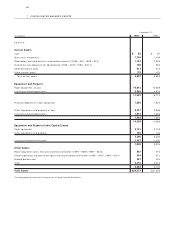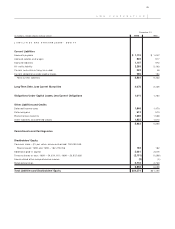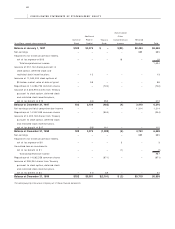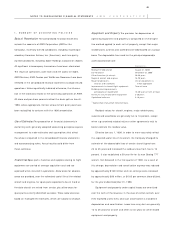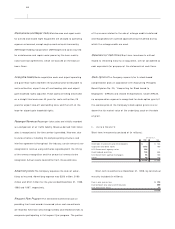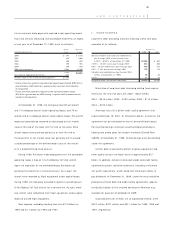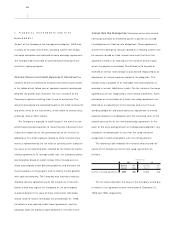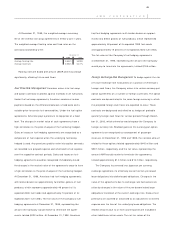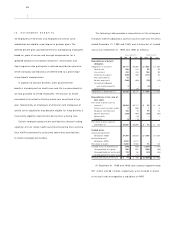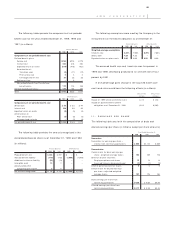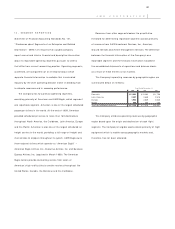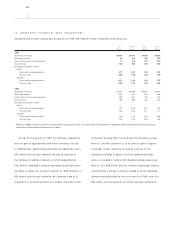American Airlines 1999 Annual Report Download - page 51
Download and view the complete annual report
Please find page 51 of the 1999 American Airlines annual report below. You can navigate through the pages in the report by either clicking on the pages listed below, or by using the keyword search tool below to find specific information within the annual report.
50
Company’s yen currency exchange agreements, representing the
amount the Company would receive or pay to terminate the
agreements, were (in millions):
December 31,
1999 1998
Notional Fair Notional Fair
Amount Value Amount Value
Japanese yen 33.6 billion $41 33.7 billion $(5)
The exchange rates on the Japanese yen agreements range
from 66.50 to 116.89 yen per U.S. dollar.
Fair Values of Financial Instruments The fair values of the
Company’s long-term debt were estimated using quoted market
prices where available. For long-term debt not actively traded, fair
values were estimated using discounted cash flow analyses, based
on the Company’s current incremental borrowing rates for similar
types of borrowing arrangements. The carrying amounts and
estimated fair values of the Company’s long-term debt, including
current maturities, were (in millions):
December 31,
1999 1998
Carrying Fair Carrying Fair
Value Value Value Value
Secured variable and fixed
rate indebtedness $2,651 $2,613 $ 890 $1,013
7.875% – 10.62% notes 1,014 1,024 875 973
9.0% – 10.20% debentures 437 469 437 531
6.0% – 7.10% bonds 176 174 176 189
Variable rate indebtedness 86 86 86 86
Other 16 16 20 20
$4,380 $4,382 $2,484 $2,812
All other financial instruments, except for the investment in
Equant, are either carried at fair value or their carrying value
approximates fair value.
Financial Accounting Standards Board Statement of Financial
Accounting Standards No. 133, “ Accounting for Derivative
Instruments and Hedging Activities” (SFAS 133), as amended, is
required to be adopted in fiscal years beginning after June 15,
2000. SFAS 133 will require the Company to recognize all deriva-
tives on the balance sheet at fair value. Derivatives that are not
hedges must be adjusted to fair value through income. If the
derivative is a hedge, depending on the nature of the hedge,
changes in the fair value of derivatives will either be offset
against the change in fair value of the hedged assets, liabilities, or
firm commitments through earnings or recognized in other
comprehensive income until the hedged item is recognized in
earnings. The ineffective portion of a derivative’s change in fair
value will be immediately recognized in earnings. The Company is
currently evaluating the impact of SFAS 133 on the Company’s
financial condition and results of operations.
7. INCOME TAXES
The significant components of the income tax provision were
(in millions):
Year Ended December 31,
1999 1998 1997
Current $167 $451 $206
Deferred 183 268 321
$350 $719 $527
The income tax provision includes a federal income tax provision
of $290 million, $628 million and $462 million and a state income
tax provision of $49 million, $78 million and $56 million for the
years ended December 31, 1999, 1998 and 1997, respectively.
The income tax provision differed from amounts computed at
the statutory federal income tax rate as follows (in millions):
Year Ended December 31,
1999 1998 1997
Statutory income tax provision $352 $641 $467
State income tax provision, net 32 51 36
Meal expense 19 18 20
Change in valuation allowance (67) (4) –
Other, net 14 13 4
Income tax provision $350 $719 $527
The change in valuation allowance in 1999 relates to the
reversal of the Company’s investment in Canadian (see Note 2).
The change in valuation allowance in 1998 relates to the


